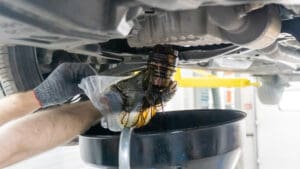Waste oil management remains one of the most critical yet often overlooked aspects of industrial, commercial, and automotive operations.
Whether you run a busy garage, manufacturing facility, or marine workshop, proper waste oil storage isn’t just good practice—it’s a legal requirement that protects your business, employees, and the environment from serious harm.
Every year, improper waste oil disposal causes significant environmental damage, with just one liter of used oil capable of contaminating up to one million liters of water. Beyond environmental concerns, inadequate storage solutions expose businesses to hefty fines, prosecution, and reputational damage. Understanding how to store waste oil safely and legally transforms a potential liability into a manageable aspect of your operations.
Understanding Waste Oil and Its Hazards
Waste oil encompasses any petroleum-based or synthetic oil that has become unsuitable for its original purpose through use or contamination. This includes engine oil, hydraulic fluid, transmission fluid, gear oil, and various industrial lubricants.
Environmental Impact
Used oil contains harmful contaminants including heavy metals like lead, cadmium, and chromium, along with toxic chemicals such as benzene and polycyclic aromatic hydrocarbons (PAHs). When improperly disposed of, these substances leach into soil and groundwater, persisting in ecosystems for decades.
A single oil change from a car produces approximately 4-5 liters of waste oil. Multiply this across thousands of garages and workshops, and the scale of potential environmental damage becomes apparent. Proper storage represents the first line of defense in preventing this contamination.
Health and Safety Concerns
Waste oil poses direct health risks to workers. Prolonged skin contact can cause dermatitis and other skin conditions, while inhalation of oil mists may lead to respiratory problems. The fire risk shouldn’t be underestimated either—while used oil has a higher flash point than fresh oil, it remains combustible and requires appropriate precautions.
Legal Framework
UK regulations governing waste oil storage are stringent and enforced through multiple legislative frameworks including the Environmental Protection Act, Water Resources Act, and Hazardous Waste Regulations. Businesses must register as waste carriers, maintain proper documentation, and ensure storage facilities meet specific standards.
Non-compliance carries serious consequences. Fines for environmental offences can reach £50,000 or more, with imprisonment possible for serious or deliberate breaches. Regular inspections by the Environment Agency mean violations rarely go undetected.
Key Considerations for Waste Oil Storage
Selecting appropriate storage solutions requires careful evaluation of your specific operational needs, site conditions, and regulatory obligations.
Capacity Assessment
Accurate capacity planning prevents overflow situations and ensures you’re not paying for excessive storage you don’t need. Calculate your waste oil generation rate by tracking volume over several weeks, then factor in collection frequency. Build in a safety margin of at least 20% to accommodate variations in production or delayed collections.
Small garages might generate 200-500 liters monthly, while larger operations or marine facilities could produce thousands of liters. Understanding your requirements forms the foundation for appropriate tank selection.
Tank Material and Construction
Waste oil tanks are typically manufactured from steel or polyethylene, each offering distinct advantages.
Steel tanks provide exceptional strength and durability, suitable for high-capacity needs and outdoor installations. Modern steel tanks feature powder-coated finishes or galvanization for corrosion resistance. Their robust construction withstands harsh conditions and accidental impacts.
Polyethylene tanks offer excellent chemical resistance, won’t rust, and typically cost less than steel equivalents. Their lighter weight simplifies installation and relocation. However, they may have lower capacity options and potentially shorter lifespans in demanding environments.
Bunded vs. Single-Skin Tanks
Bunded tanks incorporate a secondary containment layer that captures leaks or spills, preventing environmental contamination. This double-wall construction is increasingly required by regulations, particularly for tanks exceeding 200 liters or those positioned near watercourses or sensitive areas.
The bund must hold at least 110% of the tank’s capacity, ensuring complete containment even if the primary vessel fails completely. While bunded tanks cost more initially, they provide invaluable protection against expensive cleanup operations and regulatory penalties.
Single-skin tanks may still be acceptable in certain circumstances, particularly indoors where secondary containment is provided by the building structure itself, such as sealed concrete bunds or dedicated spill containment rooms.
Location and Site Requirements
Tank placement significantly impacts safety, compliance, and operational efficiency. Consider these factors:
Proximity to operations: Position tanks close enough for convenient waste collection but distant enough to minimize fire risk to occupied buildings. Typical recommendations suggest at least 10 meters from buildings, though specific requirements vary.
Ground conditions: Ensure level, stable foundations capable of supporting the tank’s full weight. Concrete bases are standard, providing stability and creating a cleanable surface for spill management.
Access for collection vehicles: Waste oil requires regular removal by licensed carriers. Ensure adequate access for tanker trucks, including turning space and clearance for hoses and equipment.
Environmental sensitivity: Maintain appropriate distances from watercourses, drains, wells, and environmentally protected areas. Consult Environment Agency guidelines for specific requirements in your location.
Weather protection: While tanks withstand outdoor conditions, weather protection extends lifespan and may be required in certain installations. Covered areas also make oil transfer operations more comfortable during adverse weather.
Essential Features and Specifications
Modern waste oil storage solutions incorporate various features that enhance safety, compliance, and usability. When you choose a waste oil tank, understanding these features helps ensure you select the most appropriate option for your needs.
Secure Access and Fill Points
Lockable lids prevent unauthorized access and tampering, crucial for both security and legal compliance. Fill points should accommodate standard waste oil collection equipment while minimizing splash and spillage. Some tanks feature multiple inlet points for different oil types or simultaneous filling from multiple collection containers.
Level Indicators
Clear level indication prevents overfilling—one of the most common causes of spills. Basic sight gauges suffice for many applications, while larger installations may benefit from electronic level monitoring systems that provide remote readings and alerts when tanks approach capacity.
Drainage and Cleaning Provisions
Tanks should include drainage points for maintenance and cleaning. Over time, water and sediment accumulate in waste oil tanks, requiring periodic removal. Properly positioned drainage valves simplify this maintenance task while ensuring you can fully empty the tank when necessary.
Ventilation
Adequate ventilation prevents pressure buildup from temperature variations and allows vapors to disperse safely. Breather vents should incorporate flame arrestors to prevent ignition sources from entering the tank while allowing air exchange.
Labeling and Identification
Clear, durable labeling identifies tank contents and provides essential safety information. Regulatory requirements mandate specific hazard warnings and content identification. Quality labels resist fading, moisture, and chemical exposure.
Installation and Setup Best Practices
Proper installation ensures your storage system functions safely and compliantly from day one.
Foundation Preparation
The foundation must be level, stable, and capable of supporting the tank’s maximum capacity. A concrete pad at least 150mm thick provides ideal support for most installations. Ensure the base extends beyond the tank footprint on all sides, creating a clean, accessible surround.
For bunded tanks, verify the base won’t impede bund drainage. Any water that accumulates in bunds must be tested before disposal to ensure it’s not contaminated with oil.
Pipework and Connections
All pipework should be of appropriate specification for petroleum products, with secure connections that won’t leak under normal operating conditions. Minimize pipework length and complexity where possible—every joint represents a potential leak point.
Install valves in accessible locations for maintenance and emergency shutoff. Clearly label all pipes indicating direction of flow and contents.
Spill Response Equipment
Keep appropriate spill response materials readily available near your storage area. This should include absorbent materials suitable for oil spills, containment booms for larger spills, and appropriate disposal containers. Ensure staff know where this equipment is located and how to use it.
Signage and Documentation
Install appropriate warning signs around your storage area, indicating hazards and access restrictions. Maintain documentation including installation records, maintenance schedules, capacity information, and emergency procedures. Keep transfer records as required by waste carrier regulations.
Maintenance and Inspection Protocols
Regular maintenance prevents problems and ensures ongoing compliance with regulations.
Routine Visual Inspections
Conduct weekly visual inspections checking for:
Signs of leakage or staining around the tank base
Damage to tank structure including dents, corrosion, or cracks
Secure operation of lids, valves, and access points
Legibility of labels and warning signs
Level indication functionality
Accumulation of water or debris in bunds
Document these inspections, noting any issues requiring attention. Many regulatory frameworks require written inspection records.
Periodic Detailed Inspections
Schedule more thorough inspections quarterly or semi-annually depending on tank age, condition, and regulatory requirements. These should examine internal tank conditions where safely possible, test level indicators for accuracy, verify ventilation systems function properly, and check structural integrity of supports and foundations.
Cleaning and Maintenance
Over time, sludge accumulates in waste oil tanks, reducing effective capacity and potentially causing operational issues. Schedule periodic cleaning by qualified contractors who can safely remove, dispose of, and clean tank interiors. Frequency depends on oil quality and volume but typically ranges from every 1-3 years.
Between professional cleanings, remove water that accumulates in bunds promptly, especially after rainfall. Test this water for oil contamination before disposal—contaminated water must be treated as hazardous waste.
Record Keeping
Maintain comprehensive records including:
Installation documentation and specifications
Inspection logs with dates, findings, and actions taken
Maintenance activities and repairs
Waste transfer notes documenting collections
Capacity information and fill level tracking
Staff training records for personnel handling waste oil
These records demonstrate compliance during inspections and provide valuable information for troubleshooting operational issues.
Operational Best Practices
How you use your waste oil storage system directly impacts safety and efficiency.
Separation of Waste Streams
Never mix different waste types in your oil tank. Contamination complicates recycling and may render the entire contents unsuitable for reclamation, requiring expensive disposal as hazardous waste. Maintain separate storage for:
Engine oils
Hydraulic fluids
Transmission fluids
Contaminated oils (mixed with solvents, coolants, etc.)
Some facilities maintain multiple tanks for different oil types, simplifying downstream recycling and potentially reducing disposal costs.
Transfer Procedures
Establish clear procedures for transferring waste oil into storage tanks:
Verify the receiving tank has adequate capacity
Check oil type matches the tank contents
Use appropriate funnels or pumps to minimize spillage
Never overfill—leave adequate ullage (space at the top)
Secure lids immediately after transfer
Clean any spillage immediately
Document the transfer quantity and date
Staff Training
Everyone handling waste oil should receive appropriate training covering:
Hazards associated with waste oil
Proper storage procedures
Spill response protocols
Regulatory requirements
Emergency procedures
Regular refresher training ensures knowledge remains current as regulations evolve and staff changes occur.
Collection and Disposal Arrangements
Proper storage forms only part of responsible waste oil management—you must also ensure compliant collection and disposal.
Licensed Waste Carriers
Only use registered waste carriers authorized to handle waste oil. Verify their license status through the Environment Agency’s public register. Reputable carriers provide appropriate documentation, including waste transfer notes that you must retain for at least two years.
Collection Frequency
Establish collection schedules that prevent tank capacity from being exceeded while avoiding unnecessarily frequent collections. Most businesses schedule collections when tanks reach 75-80% capacity, providing a buffer for unexpected generation or collection delays.
Recycling vs. Disposal
Quality waste oil can be refined and reused, making it a valuable commodity rather than simply waste. Ensure your carrier recycles oil where possible—this benefits the environment and may reduce your costs compared to disposal as hazardous waste. However, contaminated oils that can’t be recycled require proper hazardous waste disposal through licensed facilities.
Frequently Asked Questions
What size waste oil tank do I need for my workshop?
Tank size depends on your oil generation rate and collection frequency. A typical small garage conducting 20-30 oil changes monthly generates approximately 100-150 liters of waste oil. With monthly collections, a 500-liter bunded tank provides adequate capacity with safety margin. Larger operations should calculate their specific generation rates and select capacity accordingly, ensuring they never exceed 80% full between collections.
Do I legally need a bunded tank for waste oil storage?
While regulations don’t always mandate bunded tanks explicitly, they require appropriate secondary containment for oil storage. For tanks over 200 liters or those in environmentally sensitive areas, bunded tanks are effectively required. Even where single-skin tanks are technically permissible, the protection offered by bunded construction provides excellent insurance against costly spills and regulatory penalties. Most professionals recommend bunded tanks regardless of strict legal requirements.
How often should waste oil tanks be emptied?
Collection frequency depends on your generation rate and tank capacity. Most businesses schedule collections when tanks reach 75-80% capacity. For small operations, this might mean quarterly or bi-monthly collections, while high-volume facilities may require weekly or fortnightly service. Never wait until tanks are completely full—this risks overfilling and provides no buffer for unexpected increases in waste generation.
Can I store waste oil tanks indoors?
Yes, indoor storage is permissible and often preferable in terms of weather protection and temperature stability. Indoor installations require adequate ventilation to disperse vapors, appropriate fire safety measures, and typically some form of secondary containment such as bunded flooring or containment pallets. Ensure adequate access for filling and collection, and maintain appropriate separation from occupied areas, ignition sources, and incompatible materials.
What’s the typical lifespan of a waste oil storage tank?
Lifespan varies significantly based on material, conditions, and maintenance. Quality steel tanks properly maintained often exceed 15-20 years, while polyethylene tanks typically last 10-15 years. Harsh environmental conditions, poor maintenance, or exposure to incompatible chemicals can significantly reduce these estimates. Regular inspection and prompt attention to any damage or deterioration maximize tank longevity and ensure continued safe operation.
Conclusion
Effective waste oil storage protects your business from environmental liabilities while ensuring regulatory compliance and operational efficiency. The investment in quality storage infrastructure pays dividends through reduced risk, streamlined operations, and peace of mind that your waste management practices meet legal and ethical standards.
Success begins with understanding your specific needs—calculating capacity requirements, assessing site conditions, and determining which features provide the best value for your operations. Quality tanks properly installed and maintained deliver decades of reliable service, transforming waste oil management from a concerning liability into a routine, manageable aspect of your business operations.
Don’t view waste oil storage as merely a regulatory burden. Proper systems demonstrate professional responsibility, protect valuable environmental resources, and safeguard your business from potentially catastrophic incidents. Whether you’re upgrading outdated facilities or establishing waste management for a new operation, prioritizing appropriate storage solutions represents sound business practice that benefits everyone—your business, your staff, your community, and the environment we all share.






